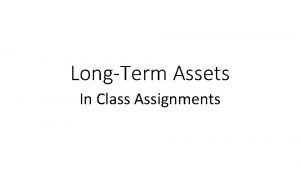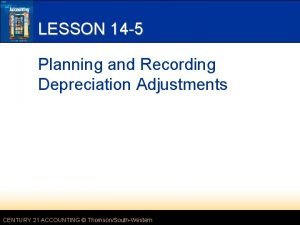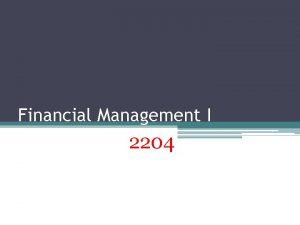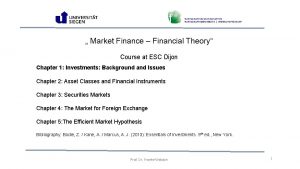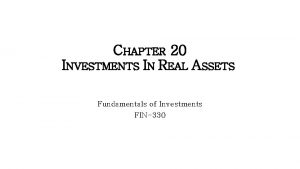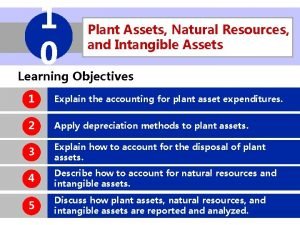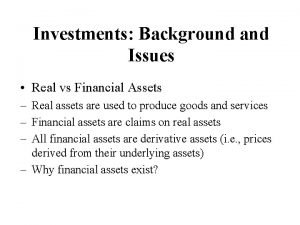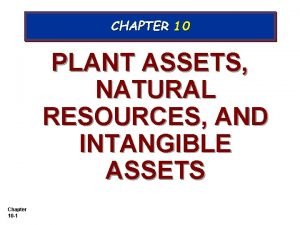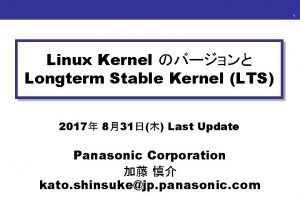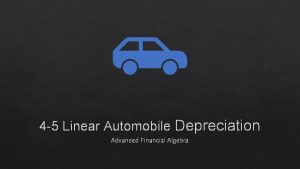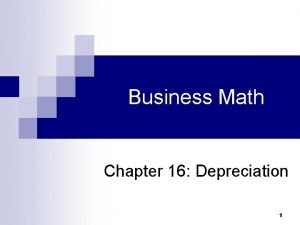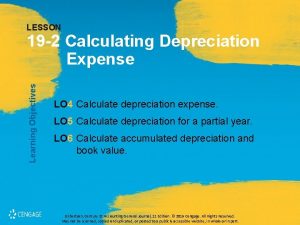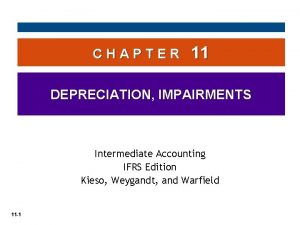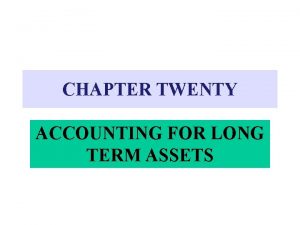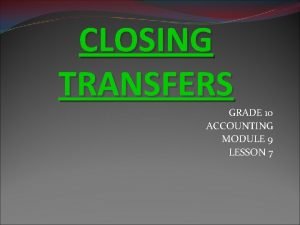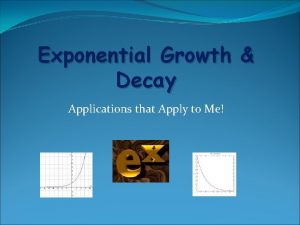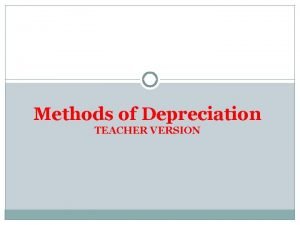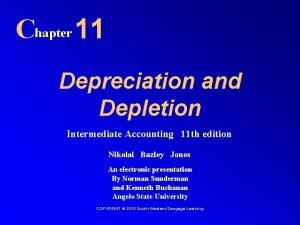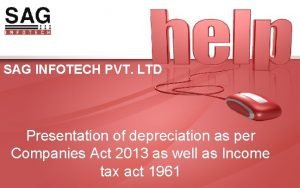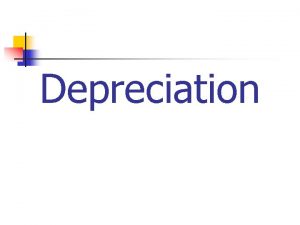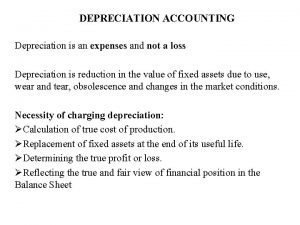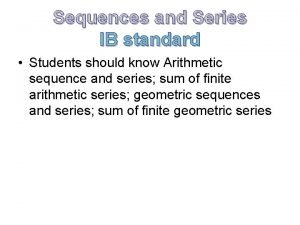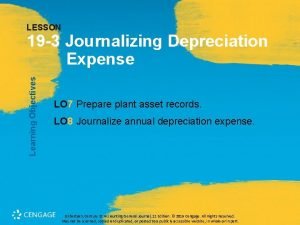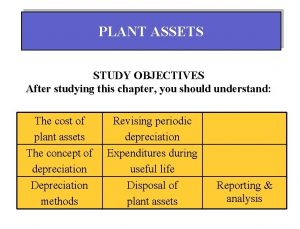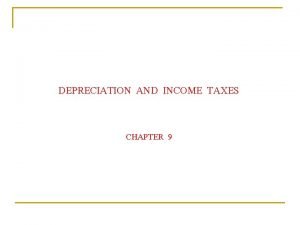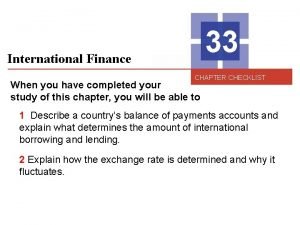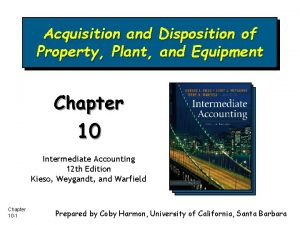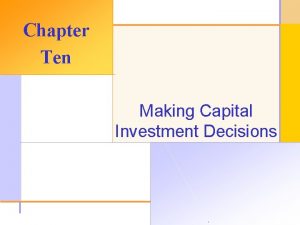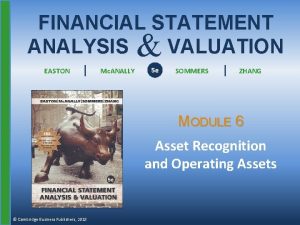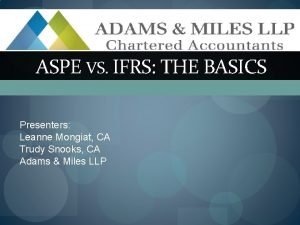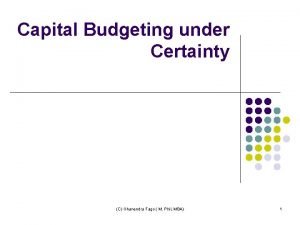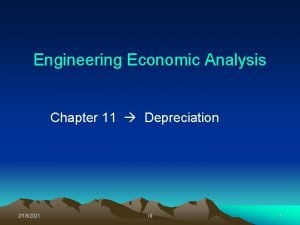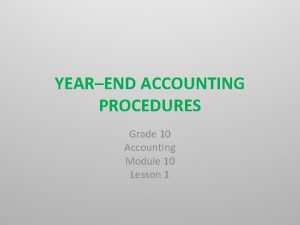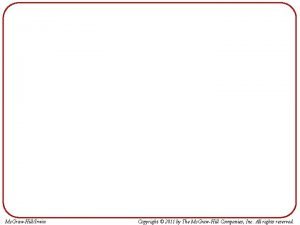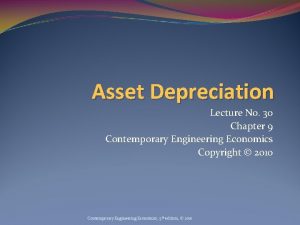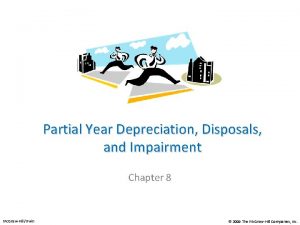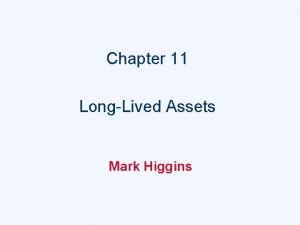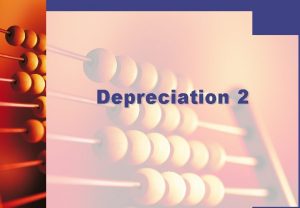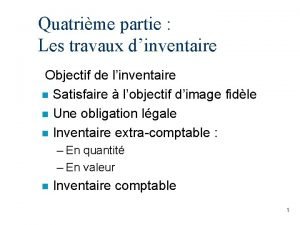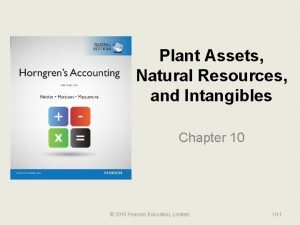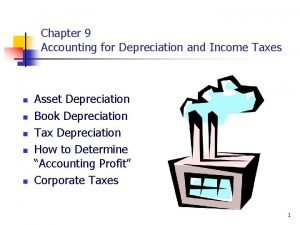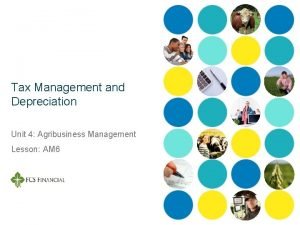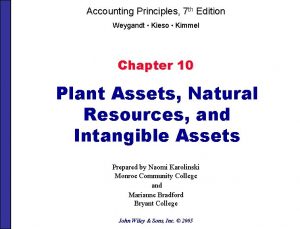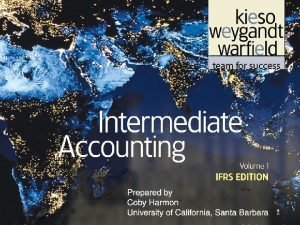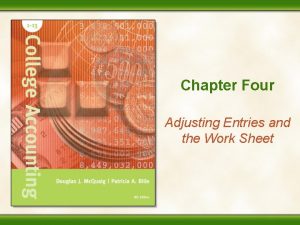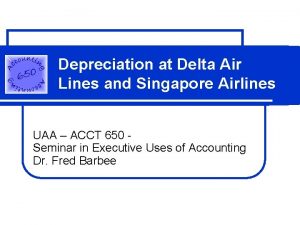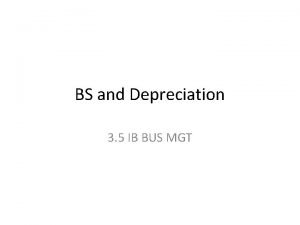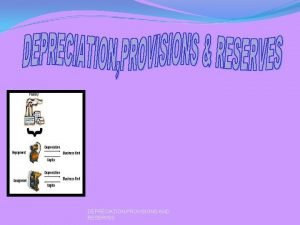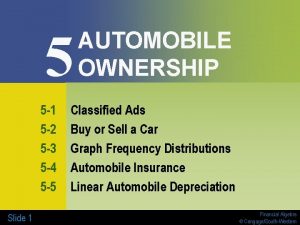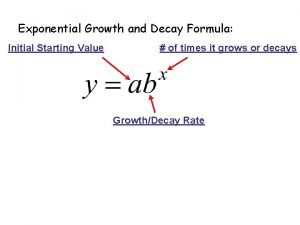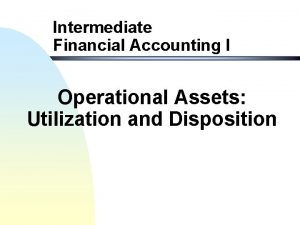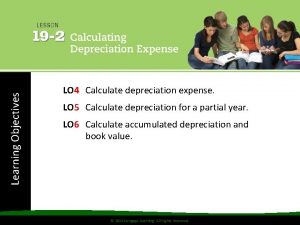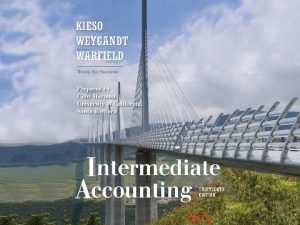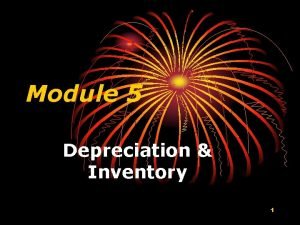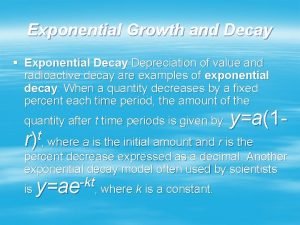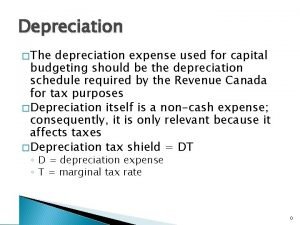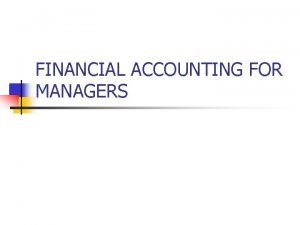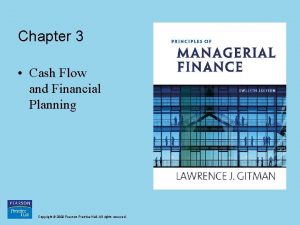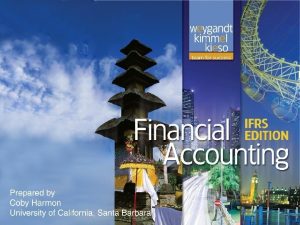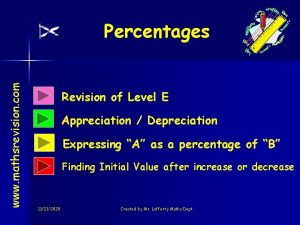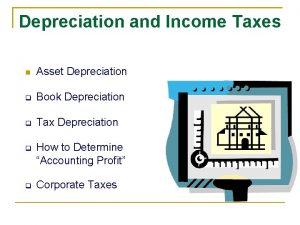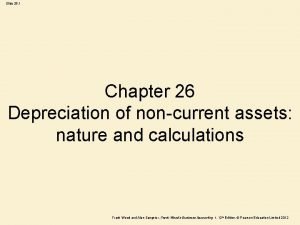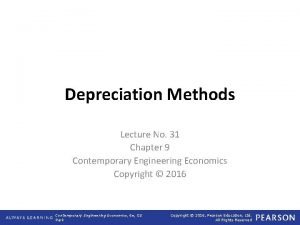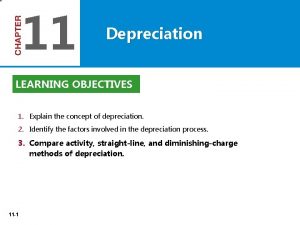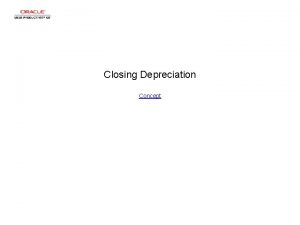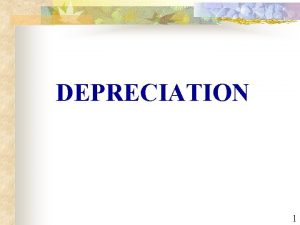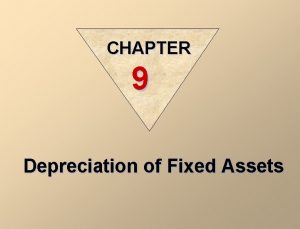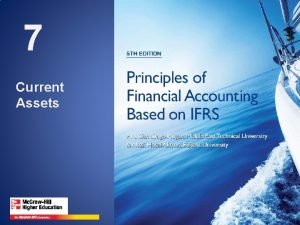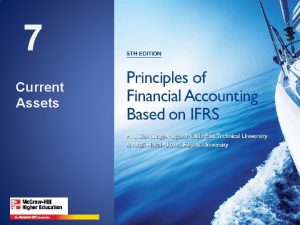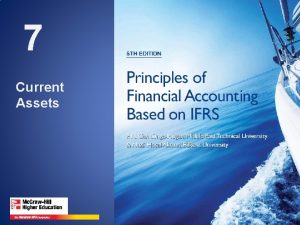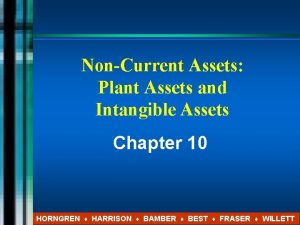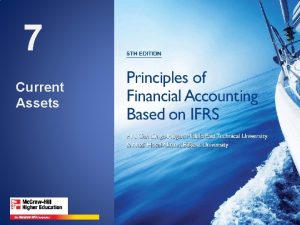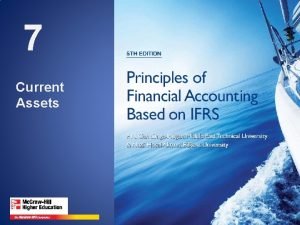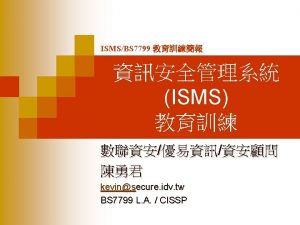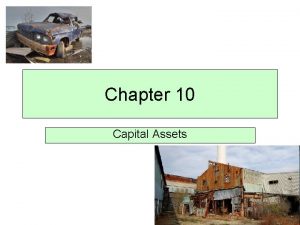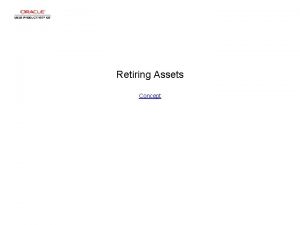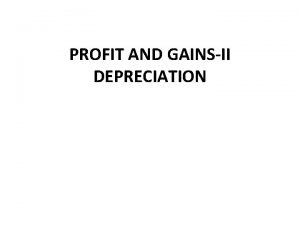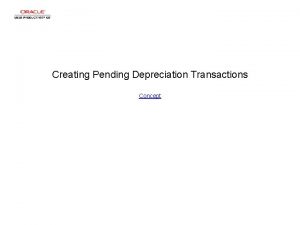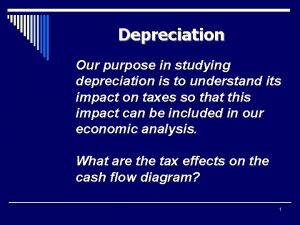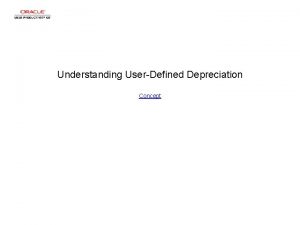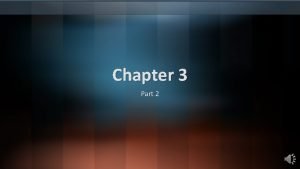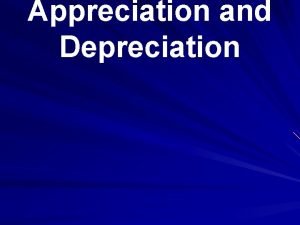LECTURE 23 LongTerm Assets Depreciation 23 Longterm Assetds











































































- Slides: 75


LECTURE 23 Long-Term Assets & Depreciation 23 - Longterm Assetds and Depreciation ©human/i. Stockphoto



Summary Lecture 22

SUMMARY LECTURE 22 1. Explained the uses of dollar and percentage changes, trends percentages, component percentages and ratios. 2. Discussed the quality of a company’s earnings, assets, and working capital. 3. Explained the nature and purpose of classifications in financial statements.

SUMMARY LECTURE 22 4. Prepared a classified balanced sheet and compute widely used measures of liquidity and credit risk. 5. Put a company’s net income int 9 o perspective by relating it to sales, assets, and stockholders’ equity. 6. Compute the ratios widely used in financial statement analysis and explained the significance of each. 7. Analyze financial statement from the viewpoints of common stckholders, creditors, and others.

LECTURE 23 Long Term Assets and Depreciation

Concepts Underlying Long-Term Assets § Long-term assets have the following characteristics: – They have a useful life of more than one year. – They are used in the operation of a business. – They are not intended for resale to customers. § Under accrual accounting, the cost of these assets, with the exception of land some intangible assets, is allocated to the periods they benefit. 23 - Longterm Assetds and Depreciation

Valuation and Disclosure of Long-Term Assets § Long-term assets are generally reported and valued at carrying value. – Carrying value (or book value) is the unexpired part of an asset’s cost. – Asset impairment occurs when the carrying value of a long-term asset exceeds its fair value—i. e. , when an asset loses some or all of its potential to generate revenue before the end of its useful life. 23 - Longterm Assetds and Depreciation

Recognition of the Acquisition Cost of Long-Term Assets § An expenditure is a payment or an obligation to make a future payment for an asset or a service. Expenditures are classified as capital expenditures or revenue expenditures. – A capital expenditure is for the purchase or expansion of a long-term asset. § Capital expenditures are recorded in asset accounts. 23 - Longterm Assetds and Depreciation

Recognition of the Acquisition Cost of Long-Term Assets – A revenue expenditure is for the ordinary repairs and maintenance needed to keep a long-term asset in good operating condition. § Revenue expenditures are recorded in expense accounts. 23 - Longterm Assetds and Depreciation

CAPITAL EXPENDITURE Vs. REVENUE EXPENDITURE – Capital Expenditure include any material expenditure that will benefit several accounting period s. Therefore, these expenditures are charged to asset accounts (capitalization) and are recognized as charged in future periods. – Revenue Expenditures are charged directly to expense accounts because either 1. There is no objective evidence of future benefits or 2. The amounts are immaterial. 23 - Longterm Assetds and Depreciation

Recognition of the Acquisition Cost of Long-Term Assets § Capital expenditures include: – outlays for plant assets, natural resources, and intangible assets – additions—enlargements to the physical layout of a plant asset – betterments—improvements to a plant asset but not an addition to the plant’s physical layout 23 - Longterm Assetds and Depreciation

Recognition of the Acquisition Cost of Long-Term Assets - extraordinary repairs—repairs that significantly enhance a plant asset’s estimated useful life or residual value; recorded by reducing the Accumulated Depreciation account § The distinction between capital and revenue expenditures is important in applying accrual accounting. 23 - Longterm Assetds and Depreciation

Acquisition Cost of Property, Plant, and Equipment § The acquisition cost of property, plant, and equipment includes all expenditures reasonable and necessary to get an asset in place and ready for use. Cost of Asset = Purchase Price + Additional Expenditures(freight, installation, etc. ) 23 - Longterm Assetds and Depreciation

Acquisition Cost of Property, Plant, and Equipment – Interest charges incurred in purchasing an asset are not a cost of the asset, but an operating expense. – Small expenditures for long-term assets may be treated as expenses if they are not material. 23 - Longterm Assetds and Depreciation

Determining the Acquisition Cost of Property, Plant, and Equipment: Land Improvements § Land: Expenditures that should be debited to the Land account include: purchase price of the land; commissions to real estate agents; lawyer’s fees; accrued taxes paid by the purchaser; costs of preparing the land to build on, such as costs of tearing down old buildings and grading the land; assessments for local improvements; and landscaping. 23 - Longterm Assetds and Depreciation

Determining the Acquisition Cost of Property, Plant, and Equipment: Land Improvements § Land Improvements: Improvements to real estate, such as driveways, parking lots, and fences, that have a limited life are subject to depreciation. They are recorded in an account called Land Improvements. 23 - Longterm Assetds and Depreciation

Determining the Acquisition Cost of Property, Plant, and Equipment: Buildings § When a company buys a building, the cost includes the purchase price and all expenditures required to put the building in usable condition. § When a company constructs its own building, the cost includes: costs of materials, labor, and overhead; architects’ fees and lawyers’ fees; insurance during construction; interest on construction loans during construction; and building permits. 23 - Longterm Assetds and Depreciation

Determining the Acquisition Cost of Property, Plant, and Equipment: Leasehold Improvements § Improvements to leased property, such as the installation of carpet or walls, on the books of the lessee that become the property of the lessor (the owner of the property) at the end of the lease are called leasehold improvements. 23 - Longterm Assetds and Depreciation

Determining the Acquisition Cost of Property, Plant, and Equipment: Leasehold Improvements – These are usually classified in the property, plant, and equipment section of the balance sheet. – The cost of these improvements is depreciated over the remaining term of the lease or the useful life of the improvement, whichever is shorter. 23 - Longterm Assetds and Depreciation

Determining the Acquisition Cost of Property, Plant, and Equipment: Equipment and Group Purchases § Equipment: The cost of equipment includes all expenditures connected with purchasing the equipment and preparing it for use. These expenditures include: invoice price less cash discounts; freight, including insurance; excise taxes and tariffs; buying expenses; installation costs; and test runs to ready the equipment for operation. § Group Purchases: Companies sometimes purchase land other assets for a lump sum. The lump sum must be apportioned between the land other assets. 23 - Longterm Assetds and Depreciation

Depreciation § Depreciation refers to the allocation of the cost of a plant asset over its estimated useful life, not to the asset’s physical deterioration or to its decrease in market value. 23 - Longterm Assetds and Depreciation

Depreciation – The major factors that limit a depreciable asset’s useful life are: § Physical deterioration—the result of use or exposure to the elements, such as sun or wind § Obsolescence—the process of becoming out of date – Depreciation is recorded even if an asset increases in value. 23 - Longterm Assetds and Depreciation

Factors in Computing Depreciation § Factors in computing depreciation include: – Cost—the net purchase price of an asset plus all expenditures to get it in place and ready for use – Residual value (or salvage, disposal, or trade-in value)—the portion of an asset’s cost that a company expects to recover when it disposes of the asset 23 - Longterm Assetds and Depreciation

Factors in Computing Depreciation § Factors in computing depreciation include: – Depreciable cost—an asset’s cost less its residual value – Estimated useful life—the total number of service units expected from a long-term asset (may be years used, units produced, or miles driven) 23 - Longterm Assetds and Depreciation

Computing Depreciation: Declining-Balance Method § An accelerated method of depreciation results in larger amounts of depreciation in the early years of an asset’s life than in later years. – Thus, depreciation charges will be highest in years when the asset is newest and when revenue generation from the asset is likely to be highest. 23 - Longterm Assetds and Depreciation

Special Issues in Determining Depreciation § Group Depreciation: Large companies group similar assets, such as machines, to calculate depreciation. § It is often necessary to calculate depreciation for partial years because assets are often purchased mid-year. § The tax law allows rapid write-offs of plant assets, which differs from the depreciation methods most companies use for financial reporting. § Sometimes the estimate of useful life is revised, so that the depreciation changes over the asset’s remaining useful life. 23 - Longterm Assetds and Depreciation

Disposal of Depreciable Assets § When plant assets are no longer useful because they have physically deteriorated or become obsolete, a company can sell them, discard them, or trade them in on the purchase of a new asset. – A company must record depreciation expense for the partial year up to the date of disposal. – The carrying value of a fully depreciated asset is zero if it has no residual value. When the asset is discarded, no gain or loss results. – For an asset with a carrying value, a loss equal to the carrying value should be recorded when it is discarded. 23 - Longterm Assetds and Depreciation

Exchanges of Plant Assets § Exchanges may involve similar assets, such as an old machine traded in on a newer model, or dissimilar assets, such as a cement mixer traded in on a truck. – In both cases, the purchase price is reduced by the amount of the trade-in allowance. § If the trade-in allowance is greater than the asset’s carrying value, the company realizes a gain. § If the allowance is less, it suffers a loss. 23 - Longterm Assetds and Depreciation

Natural Resources § Natural resources are long-term assets that are converted to inventory by cutting, pumping, mining, or other extraction methods. – They are recorded at acquisition cost. As these resources are converted to inventory, their asset accounts must be proportionately reduced. 23 - Longterm Assetds and Depreciation

Natural Resources – The useful life of the plant assets used to extract the natural resources may be longer than the time it will take to extract the resources. § If a company plans to abandon these assets after all the resources have been extracted, they should be depreciated on the same basis as depletion of the natural resources. 23 - Longterm Assetds and Depreciation

Depletion § Depletion refers not only to the exhaustion of a natural resource but also to the proportional allocation of the cost of a natural resource to the units extracted. 23 - Longterm Assetds and Depreciation

Depletion – When a natural resource is purchased or developed, the total units that will be available, such as tons of coal, must be estimated. – The depletion cost per unit is computed as follows. Depletion Cost per Unit = Cost − Residual Value Estimated Number of Units 23 - Longterm Assetds and Depreciation

Development and Exploration Costs in the Oil and Gas Industry -illustration Exploring and developing oil and gas resources can be accounted for under one of two methods: § Successful efforts accounting—Under this method, the cost of successful exploration is a cost of the resource. – It is recorded as an asset and depleted over the resource’s estimated life. The cost of unsuccessful exploration is written off immediately as a loss. 23 - Longterm Assetds and Depreciation

Development and Exploration Costs in the Oil and Gas Industry -illustration Exploring and developing oil and gas resources can be accounted for under one of two methods: § Full-costing method—Under this method, all costs of exploration are recorded as assets and depleted over the estimated life of the resources. – This includes the costs of unsuccessful exploration, such as the cost of dry wells. 23 - Longterm Assetds and Depreciation

Double-Declining- Balance § The accelerated depreciation rate as a “ specified percentage” of the straight-line rate. § Most often, this specified percentage is 200 -%, § Meaning that the accelerated rate is exactly twice the straight-line rate. § As a result, the declining-balance method of depreciation often is called double-declining- balance (i. e. 200%-declining-balance) § The percentage may be specified a lower percentage such as 150% of the straight-line rate , called “ 150%- declining-balance”.

The Declining-Balance Method § The most widely used accelerated depreciation method is called “ fixedpercentage-of- declining-balance depreciation. § However method is used primarily in income tax returns, rather than financial statements. § Depreciation Expense = [Remaining book value x Accelerated Depreciation rate]

The Declining-Balance Method § The accelerated depreciation rate remains constant throughout the life of the asset. Hence “fixed-percentage” § The book value (cost minus accumulated depreciation) decreases every year so “declining-balance”.

MACRS: The Tax Method § The Modified Accelerated Cost Recovery System, (MACRS ( Pronounced as “makers”. § MACRS is the only accelerated depreciation method that may be used in federal income tax returns (in USA for assets placed in service after 1986). § Under MACRS, all plants are assigned one recovery periods: 3, 5, 7, 10, 15, 20, 27 ½, 31 1/ 2, and 39 years.

MACRS DEPRECIATION BY CLASS OF PROPERTY Year 3 -year 5 -year 7 -year 10 -year 15 -year 20 -year 1 33. 33% 20. 00% 14. 29% 10. 00% 5. 00% 3. 750% 2 44. 45 32. 00 24. 49 18. 00 9. 50 7. 219 3 14. 81* 19. 20 17. 49 14. 40 8. 55 6. 677 4 7. 41 11. 52 12. 49 11. 52 7. 70 6. 177 5 11. 52 8. 93* 9. 22 6. 93 5. 713 6 5. 76 8. 92 7. 37 6. 23 5. 285 7 8. 93 6. 55* 5. 90* 4. 888 8 4. 46 � 6. 55 5. 90 4. 522 9 � 6. 56 5. 91 4. 462 10 � 6. 55 5. 90 4. 461 11 � 3. 28 5. 90 4. 452 12 5. 90 4. 461 13 5. 91 4. 462 14 5. 90 4. 461

MACRS DEPRECIATION BY CLASS OF PROPERTY Year 3 -year 5 -year 7 -year 10 -year 15 -year 20 -year 15 5. 91 4. 462 16 2. 95 4. 461 17 4. 462 18 4. 461 19 4. 462 20 4. 461 21 2. 231 Total 100% 100%

Problem 23. 1 Atlantic Iron Works Depreciation On October 26, 1998, Atlantic Iron Works acquired new machinery at a cost of $50, 000. The machinery has an estimated useful life of 5 years, with a residual value of $20, 000. For income tax purposes, this machinery qualifies as 3 -year property.

Problem 23. 1 Atlantic Iron Works Depreciation Instructions: a. Compute the annual depreciation expense for each year using each of the two depreciation methods listed below. Because you will record depreciation for only a fraction of a year in 1998, the straight-line depreciation schedule will extend to the year 2003. 1. Straight-line, using the half-year convention. 2. MACRS, the method Atlantic uses in its income tax returns. b. In this situation, would it be appropriate for Atlantic Iron to use MACRS in its financial statements as well as in its income tax returns? Explain the reasoning behind your answer.

Problem 23. 1 Atlantic Iron Works Depreciation October 26, 1998 - 2003 Depreciation Period - Year Straight Line MACRS $ 1998 3, 000 16, 665 1999 6, 000 22, 225 2000 6, 000 7, 405 2001 6, 000 3, 705 2002 6, 000 0 2003 3, 000 0 30, 000 50, 000 Totals

Problem 23. 1 Atlantic Iron Works Supporting Computations $ Total Cost of Equipment 50, 000 Residual Value 20, 000 Useful Life Date of Acquisition 5 yrs. October 26, 1998 Straight Line Computations: (Using Half Year Convention) 1998: (50, 000 -20, 000)x 1/5 x 1/2 = 3, 000 1999 – 2002: (50, 000 -2, 000)x 1/5=6, 000 2003: (50, 000 -20, 000)x 1/5 x 1/2 = 3, 000

Problem 23. 1 Atlantic Iron Works Supporting Computations $ Total Cost of Equipment 50, 000 Residual Value 20, 000 Useful Life Date of Acquisition 5 yrs. October 26, 1998 MACRS Computations: (accelerated rates for “ 3 -years property) 1998: 50, 000 x 33. 33% = 16, 685 1999: 50, 000 x 44. 45% = 22, 225 2000: 50, 000 x 14. 81% = 7, 405 2001: 50, 000 x 7. 41% = 3, 705

Problem 23. 1 - b Atlantic Iron Works Supporting Computations In the situation above, would it be appropriate for Atlantic Iron to use MACRS in its financial statements as well as in its income tax returns? Explain the reasoning behind your answer. § In this case, it would not be appropriate for Atlantic to use MACRS in its financial statements. The MACRS recovery period of 3 years is substantially shorter than the machinery’s estimated useful life. § Also, MACRS makes no provision for the estimated residual value, which is substantial. § Thus, MACRS would not result in a reasonable allocation of casts over the 5 -year period that Atlantic expects to receive services from this machinery.

Problem 23. 2 MICRO CIRCUIT CO. Micro Circuit Co. purchased new equipment on October 4, 1998, at a cost of $8, 000. The useful life of this equipment was estimated at 5 years, with no salvage value. Instructions: a. Beginning with calendar year 1998, compute the annual depreciation expense for each year using each of the new methods listed below. 1. Straight-line, with depreciation in fractional years rounded to the nearest month. 2. MACRS (Under MACRS guidelines, this equipment is classified as 5 -year property. ) b. In this situation, would it be appropriate for Micro Circuit to use MACRS in both its financial statements and its federal income tax returns? Explain the reasoning?

Problem 23. 2 AICRO CIRCUIT CO. Supporting Computations $ Total Cost of Equipment 80, 000 Residual Value 0 Useful Life Date of Acquisition 5 yrs. October 04, 1998 Straight Line Computations: (Using fractional years rounded to the nearest month) 1998: (80, 000)x 1/5 x 3/12 = 4, 000 1999 – 2002: (80, 000)x 1/5 = 16, 000 2003: (80, 000)x 1/5 x 9/12 = 12, 000

Problem 23. 2 Atlantic Iron Works Supporting Computations $ Total Cost of Equipment 80, 000 Residual Value 00 Useful Life Date of Acquisition 5 yrs. October 04, 1998 MACRS Computations: (accelerated rates for “ 5 -years property) 1998: 80, 000 x 20. 00% = 16, 000 1999: 80, 000 x 32. 00% = 25, 600 2000: 80, 000 x 19. 20% = 15, 360 2001: 80, 000 x 11. 52% = 9, 216 2002: 80, 000 x 11. 52% = 9, 216 2003: 80, 000 x 5. 76% = 4, 608

Problem 23. 2 AICRO CIRCUIT CO. Depreciation October 04, 1998 - 2003 Depreciation Period - Year Straight Line MACRS $ 1998 4, 000 16, 000 1999 16, 000 25, 600 2000 16, 000 15, 360 2001 16, 000 9, 216 2002 16, 000 9, 216 2003 12, 000 4, 608 80, 000 Totals

Problem 23. 2 - b AICRO CIRCUIT CO. Depreciation Analyses In the situation above, would it be appropriate for Micro Circuit to use MACRS in both its financial statements and its federal income tax returns? Explain the reasoning? § In this case, it would be income e appropriate for Micro Circuit to use MACRS in both its federal tax returns and its financial statements. § By law, MACRS is acceptable in the federal income tax returns. § MACRS is basically 2% -declining –balance (on 5 - year property) with half year convention, which is an acceptable method for use in financial statements.

Problem 23. 2 - b AICRO CIRCUIT CO. Depreciation Analyses In the situation above, would it be appropriate for Micro Circuit to use MACRS in both its financial statements and its federal income tax returns? Explain the reasoning? § The only question, therefore, is weather the MACRS classification as 5 -year property and providing no salvage value will result in a reasonable allocation of cost over the asset’s useful life. § In this case, these MACRS assumptions coincide with the financial statement estimates.

Intangible Assets § An intangible asset’s value comes from the longterm rights it affords its owner. 23 - Longterm Assetds and Depreciation

Purchase of Intangible Assets § Intangible assets are accounted for at the amount that a company paid for them and should be included on a company’s balance sheet only if purchased from another party at a price established in the marketplace. – The useful life of an intangible asset is the period over which the asset is expected to contribute to the company’s future cash flows. It may be: § Definite—subject to a legal limit or can be reasonably estimated § Indefinite—not limited by legal, regulatory, contractual, competitive, economic, or other factors (and not amortized) 23 - Longterm Assetds and Depreciation

Research and Development Costs § Research and development (R&D) activities include development of new products, testing of existing and proposed products, and pure research. – The FASB requires that all R&D costs be charged to expense in the period in which they are incurred. 23 - Longterm Assetds and Depreciation

Research and Development Costs – Costs that companies incur in developing software for sale or lease or for their own use are considered R&D costs until the product has proved feasible. – Once proved feasible, all software production costs are recorded as assets and amortized over the software’s estimated useful life, using the straight-line method. 23 - Longterm Assetds and Depreciation

Goodwill § From an accounting standpoint, goodwill exists when a purchaser pays more for a business than the fair market value of the business’s net assets. – Goodwill may reflect customer satisfaction, good management, efficiency, having a monopoly, good locations, and good employee relations. 23 - Longterm Assetds and Depreciation

Goodwill – The FASB requires that purchased goodwill be reported as a separate line item on the balance sheet and that it be reviewed annually for impairment. – A company should record goodwill only when it acquires a controlling interest in another business. 23 - Longterm Assetds and Depreciation

Management Decisions Relating to Long-Term Assets § A company may need to finance major acquisitions of long-term assets with the issue of stock, longterm notes, or bonds. § A measure of a company’s success in funding these acquisitions is free cash flow. 23 - Longterm Assetds and Depreciation

Management Decisions Relating to Long-Term Assets - Free cash flow is the amount of cash that remains after deducting the funds a company must commit to continue operating at its planned level. § The commitments include: current or continuing operations, interest, income taxes, dividends, and net capital expenditures (purchases of plant assets minus sales of plant assets). 23 - Longterm Assetds and Depreciation

Free Cash Flow § Free cash flow is computed as follows: Free Cash Flow = Net Cash Flows from Operating Activities − Dividends − Purchases of Plant Assets + Sales of Plant Assets – A positive free cash flow means that a company has met all its cash commitments and has cash available to reduce debt or to expand operations. – A negative free cash flow means that it will have to sell investments, borrow money, or issue stock to continue at its planned level. 23 - Longterm Assetds and Depreciation

Ethics in Acquiring and Financing Long-Term Assets § When a company acquires a long-term asset, it defers some of the asset’s cost to later periods. – Thus, the current period’s profitability looks better than it would if the asset’s total cost had been expensed. 23 - Longterm Assetds and Depreciation

Ethics in Acquiring and Financing Long-Term Assets § To avoid fraudulent reporting of long-term assets, a company’s management must apply accrual accounting in resolving two important issues: – The amount of the total cost of a long-term asset to allocate to expense in the current period. – The amount to retain on the balance sheet as an asset. 23 - Longterm Assetds and Depreciation

Ethics in Acquiring and Financing Long-Term Assets – To resolve these issues, management must answer four important questions: 1. How is the cost of the long-term asset determined? 2. How should the expired portion of the cost of the long-term asset be allocated against revenues over time? 3. How should subsequent expenditures, such as repairs and additions, be treated? 4. How should disposal of the long-term asset be recorded? 23 - Longterm Assetds and Depreciation

SUMMARY OF THE LECTURE # 23 1. Determined the cost of plant assets 2. Distinguished between capital expenditures and revenue expenditures. 3. Computed depreciation by the straight-line and declining balance method. 4. Computed depreciation for income tax purposes using MACRS.

SUMMARY OF THE LECTURE # 23 5. Accounted for disposals of plant assets. 6. Explained the nature of intangible assets, including goodwill. 7. Accounted for the depletion of natural recourses. 8. Explained the cash effects of transactions involving plant assets.

Factors in Computing Depreciation § Factors in computing depreciation include: – Cost—the net purchase price of an asset plus all expenditures to get it in place and ready for use – Residual value (or salvage, disposal, or trade-in value)—the portion of an asset’s cost that a company expects to recover when it disposes of the asset 23 - Longterm Assetds and Depreciation

Factors in Computing Depreciation § Factors in computing depreciation include: – Depreciable cost—an asset’s cost less its residual value – Estimated useful life—the total number of service units expected from a long-term asset (may be years used, units produced, or miles driven) 23 - Longterm Assetds and Depreciation

Intangible Assets § An intangible asset’s value comes from the longterm rights it affords its owner. 23 - Longterm Assetds and Depreciation

23 - Longterm Assetds and Depreciation

23 - Longterm Assetds and Depreciation

 Cala manufacturing purchases a large lot
Cala manufacturing purchases a large lot Assetd
Assetd Recorded depreciation expense on the plant assets
Recorded depreciation expense on the plant assets Real assets vs financial assets
Real assets vs financial assets Financial assets examples
Financial assets examples Types of real assets
Types of real assets Plant assets, natural resources, and intangible assets
Plant assets, natural resources, and intangible assets Plant assets natural resources and intangible assets
Plant assets natural resources and intangible assets Financial assets and real assets
Financial assets and real assets Accumulated depreciation straight line method
Accumulated depreciation straight line method Linux kernel longterm
Linux kernel longterm Thomas silverstein art
Thomas silverstein art 01:640:244 lecture notes - lecture 15: plat, idah, farad
01:640:244 lecture notes - lecture 15: plat, idah, farad Linear depreciation function
Linear depreciation function What is depreciation in maths
What is depreciation in maths Depreciation expense
Depreciation expense Kunci jawaban buku intermediate accounting ifrs chapter 11
Kunci jawaban buku intermediate accounting ifrs chapter 11 Sum of the years method of depreciation
Sum of the years method of depreciation Closing transfers accounting
Closing transfers accounting Exponential decay car depreciation worksheet
Exponential decay car depreciation worksheet Double declining method depreciation
Double declining method depreciation Composite depreciation rate
Composite depreciation rate Akubation
Akubation Appreciation and depreciation of currency
Appreciation and depreciation of currency Depreciation motor vehicle
Depreciation motor vehicle Depreciation in accounting
Depreciation in accounting Geometric sequemce
Geometric sequemce Deemed depreciation fbt
Deemed depreciation fbt Depreciation expense example
Depreciation expense example Units of activity method
Units of activity method Cost of goods sold depreciation
Cost of goods sold depreciation Exchange rate depreciation example
Exchange rate depreciation example Acquisition and disposition of property plant and equipment
Acquisition and disposition of property plant and equipment Cca tax shield calculator
Cca tax shield calculator Days of inventory outstanding
Days of inventory outstanding Aspe 3065
Aspe 3065 Investment decision under certainty
Investment decision under certainty Soyd depreciation
Soyd depreciation Depreciation grade 10
Depreciation grade 10 Double declining method depreciation
Double declining method depreciation Depreciation classification
Depreciation classification Partial year depreciation
Partial year depreciation Double declining method
Double declining method Provision for depreciation
Provision for depreciation Provision pour dépréciation des titres
Provision pour dépréciation des titres Accumulated depreciation journal entry
Accumulated depreciation journal entry Exponential decay car depreciation worksheet
Exponential decay car depreciation worksheet Depreciation straight line method
Depreciation straight line method Cost of goods sold depreciation
Cost of goods sold depreciation Macrs depreciation formula
Macrs depreciation formula Double decline balance method formula
Double decline balance method formula Journal entry for revaluation of assets
Journal entry for revaluation of assets Contra account meaning
Contra account meaning Objectives of depreciation
Objectives of depreciation Singapore air lines
Singapore air lines Straight line method of depreciation
Straight line method of depreciation Machine hour method of depreciation
Machine hour method of depreciation Rachel has $25 000 worth of property damage insurance
Rachel has $25 000 worth of property damage insurance A=pert
A=pert Macrs depreciation formula
Macrs depreciation formula Calculate accumulated depreciation
Calculate accumulated depreciation Chapter 11 depreciation
Chapter 11 depreciation Inventory method of depreciation
Inventory method of depreciation Exponential depreciation
Exponential depreciation Exponential decay funtion
Exponential decay funtion Capital budgeting depreciation
Capital budgeting depreciation What is accountancy
What is accountancy Isolux diagram for finding luminance on road surface
Isolux diagram for finding luminance on road surface Macrs depreciation table
Macrs depreciation table Units-of-activity method of depreciation
Units-of-activity method of depreciation Appreciation and depreciation maths
Appreciation and depreciation maths Depreciation recapture
Depreciation recapture Macrs depreciation table
Macrs depreciation table Causes of depreciation
Causes of depreciation Macrs depreciation formula
Macrs depreciation formula Objectives of depreciation
Objectives of depreciation
